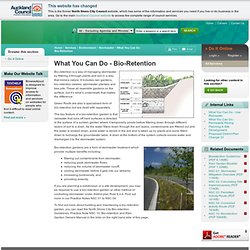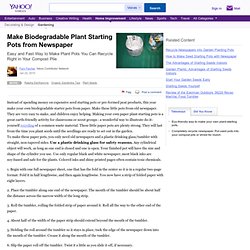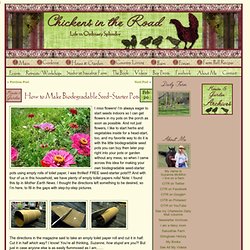

Untitled. Bio-retention is a way of managing stormwater by filtering it through plants and soil in a way that mimics nature.

It includes rain gardens, bio-retention swales, stormwater planters and tree pits. These all resemble gardens on the surface, but it’s what’s underneath that makes the difference. Green Roofs are also a specialised form of bio-retention but are dealt with separately. The key feature of a bio-retention garden is that rainwater that runs off hard surfaces is directed to the surface of a sunken garden where it temporarily ponds before filtering down through different layers of soil to a drain. As the water filters down through the soil layers, contaminants are filtered out and the water is slowed down; some water is stored in the soil and is taken up by plants and some filters down to recharge the groundwater table. Make Biodegradable Plant Starting Pots from Newspaper.
Instead of spending money on expensive seed starting pots or pre-formed peat products, this year make your own biodegradable starter pots from paper.

Make these little pots from old newspaper. They are very easy to make, and children enjoy helping. Making your own paper plant starting pots is a great earth-friendly activity for classrooms or scout groups - a wonderful way to illustrate do-it-yourself recycling of a common waste material. These little paper pots are plenty strong. They will last from the time you plant seeds until the seedlings are ready to set out in the garden. To make these paper pots, you only need old newspapers and a plastic drinking glass/tumbler with straight, non-tapered sides. 1. 2. 3. 4. 5. 6. 7. 8. Customize your paper pots by using different sizes of cylinders and different folding methods.
When plants are growing in these pots, the paper will be moist. When it is time to transplant your seedlings into the garden, carefully remove the paper pots. How to Make Biodegradable Seed-Starter Pots. I miss flowers!

I’m always eager to start seeds indoors so I can get flowers in my pots on the porch as soon as possible. And not just flowers, I like to start herbs and vegetables inside for a head-start, too, and my favorite way to do it is with the little biodegradable seed pots you can buy then later pop right into your pots or garden without any mess, so when I came across this idea for making your own biodegradable seed-starter pots using empty rolls of toliet paper, I was thrilled!
FREE seed-starter pots!!!! And with four of us in this household, we have plenty of empty toilet papers rolls! Note: I found this tip in Mother Earth News. The directions in the magazine said to take an empty toilet paper roll and cut it in half. THIS is the right way to cut it in half. By the way, I am thinking one of these empty toilet paper roll photos is surely my winning ticket to beat that slice of cornbread in next year’s Black Walnut Festival photography competition, don’t you? Isn’t that fun? Erosion in a Bottle. Erosion in a Bottle: Modeling Rain & Runoff Students construct models to simulate and investigate the effects of soil erosion on water quality.

As a follow-up activity, students may take action to prevent erosion in their schoolyard.Best for Grades 4,560 minutes Lesson Files. StudentCover - student_activities.pdf. Stream Erosion in Paint Trays. Science experiment on soil erosion Sweet porridge… This post is also available in: Italiano Science experiment on soil erosion – This experiment, which has a tremendous visual impact due to its simplicity, it will demonstrate the relationship between precipitation, soil erosion, protection of watercourses and vegetation.

A very simple experiment that stresses the importance of the vegetation cover of the soil. You can propose in three versions: – Preparing the planting of seedlings – Using plants ready to be transplanted – Using soil samples. Science experiment on soil erosion – First version Prepare three identical plastic bottles, cut as shown in the pictures and put them on a flat surface (I’ve stuck with the hot glue on a tablet of plywood): the opening of the three bottles should protrude a little out of the surface. Cut the bottom of other three bottles of transparent plastic, and make two holes for the string. Then put the cap on the first bottle in which to plant the seeds: Here are the pictures taken two weeks after sowing: